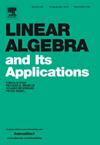Generating all regular rational orthogonal matrices
IF 1.1
3区 数学
Q1 MATHEMATICS
引用次数: 0
Abstract
A rational orthogonal matrix Q is an orthogonal matrix with rational entries, and Q is called regular if each of its row sum equals one, i.e., where e is the all-one vector. This paper presents a method for generating all regular rational orthogonal matrices using the classic Cayley transformation. Specifically, we demonstrate that for any regular rational orthogonal matrix Q, there exists a permutation matrix P such that QP does not possess an eigenvalue of −1. Consequently, Q can be expressed in the form , where is the identity matrix of order n, S is a rational skew-symmetric matrix satisfying , and P is a permutation matrix. Central to our approach is a pivotal intermediate result, which is of independent interest: given a square matrix M, then MP has −1 as an eigenvalue for every permutation matrix P if and only if either every row sum of M is −1 or every column sum of M is −1.
生成所有正则有理正交矩阵
一个有理数正交矩阵Q是一个有有理数项的正交矩阵,如果它的每一行和都等于1,那么Q被称为正则矩阵,即Qe=e,其中e是全一向量。本文给出了一种利用经典的Cayley变换生成所有正则有理正交矩阵的方法。具体地说,我们证明了对于任意正则有理正交矩阵Q,存在一个使QP不具有特征值为−1的置换矩阵P。因此,Q可以表示为Q=(in +S)−1(in−S)P,其中in是n阶的单位矩阵,S是满足Se=0的有理偏对称矩阵,P是置换矩阵。我们的方法的中心是一个关键的中间结果,它是独立的兴趣:给定一个方阵M,那么MP具有−1作为每个排列矩阵P的特征值当且仅当M的每个行和为−1或M的每个列和为−1。
本文章由计算机程序翻译,如有差异,请以英文原文为准。
求助全文
约1分钟内获得全文
求助全文
来源期刊
CiteScore
2.20
自引率
9.10%
发文量
333
审稿时长
13.8 months
期刊介绍:
Linear Algebra and its Applications publishes articles that contribute new information or new insights to matrix theory and finite dimensional linear algebra in their algebraic, arithmetic, combinatorial, geometric, or numerical aspects. It also publishes articles that give significant applications of matrix theory or linear algebra to other branches of mathematics and to other sciences. Articles that provide new information or perspectives on the historical development of matrix theory and linear algebra are also welcome. Expository articles which can serve as an introduction to a subject for workers in related areas and which bring one to the frontiers of research are encouraged. Reviews of books are published occasionally as are conference reports that provide an historical record of major meetings on matrix theory and linear algebra.

 求助内容:
求助内容: 应助结果提醒方式:
应助结果提醒方式:


